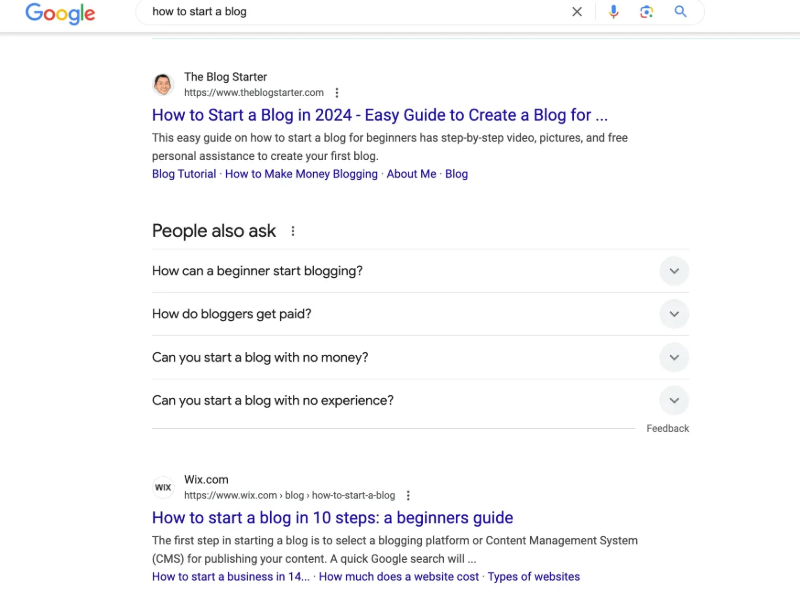If you’re adhering to SEO best practices, you’ve likely developed a robust content strategy centered on bottom-of-the-funnel (BOFU) keywords. These high-converting terms are crucial for driving revenue. However, you might feel stuck as growth stagnates and generating new content ideas becomes increasingly challenging.
This is where Jobs to Be Done (JTBD) keywords come into play. JTBD keywords reveal underlying problems that potential customers are facing, even when they aren’t explicitly searching for your product or competitors.
By focusing on JTBD keywords, you can address your audience’s pain points, attract fresh traffic, and expand beyond the limitations of traditional BOFU content. In this guide, we’ll explore how to identify and leverage JTBD keywords to rejuvenate your content strategy and tap into an overlooked source of conversions.
What Are JTBD Keywords?

Jobs-to-be-done (JTBD) keywords go beyond capturing direct product searches. Instead, they focus on the underlying tasks or goals customers are trying to accomplish—tasks they may not even realize your product can help with. Developed through frameworks by thinkers like Theodore Levitt and popularized in the SEO space by the Grow & Convert agency, JTBD keywords allow you to tap into real-world problems that motivate search behavior, reaching customers earlier in their journey.
Why JTBD Keywords Matter
Traditional product and category keywords capture customers who are already solution-focused. JTBD keywords, by contrast, reach users still exploring how to solve a problem. By aligning your content strategy with these intent-driven searches, you’re connecting with audiences who have unmet needs your product can fulfill. For example, consider the case of accounting software—users may not start their search looking for software but instead with a specific task or challenge. Let’s break down the main types of JTBD keywords and explore how each can drive meaningful traffic to your content.
Types of JTBD Keywords
1. “How to” Keywords
These keywords reflect specific tasks users are trying to complete, such as “how to track business expenses” or “how to manage payroll for freelancers.” Someone searching for “how to set up accounting for a new business” may not be actively looking for accounting software, but they’re clearly seeking a way to streamline this process. By creating content around “how to” terms, you can introduce your product as a tool that makes these tasks faster, easier, and more efficient.
Example:
In a blog titled, “How to Set Up Accounting for a New Business,” you could showcase how accounting software simplifies the entire setup process, helping new business owners save time and avoid errors. This type of content meets users where they are and subtly positions your product as the go-to solution.
2. “Ways to” Keywords
With these keywords, users are typically open to a range of solutions. Queries like “ways to reduce accounting costs” or “ways to improve cash flow” show users seeking options. By presenting your product among several practical solutions, you can demonstrate its advantages without appearing overly promotional.
Example:
A post titled “5 Ways to Reduce Accounting Costs” could include a section on how accounting software automates tasks and reduces the need for costly outsourcing, illustrating cost savings directly. This type of JTBD keyword helps audiences weigh options, with your product standing out as an efficient, cost-effective choice.
3. “Can you/Should you” Keywords
These keywords indicate users are weighing different approaches, such as “should you hire a CPA for business taxes” or “can you do accounting without hiring a CPA.” Addressing these queries allows you to outline scenarios where your product is a viable alternative.
Example:
In a guide like, “Should You Hire a CPA or Use Accounting Software for Business Taxes?” you could highlight how software offers scalability and affordability, especially for startups and small businesses. This content answers users’ questions while positioning your product as the smarter choice for specific situations.
Why JTBD Keywords Work
JTBD keywords effectively reach users who are still defining the “job” they need done. By addressing these tasks directly, you can position your product as the solution they need—right at the moment they’re most open to guidance. This approach not only attracts high-intent traffic but also builds trust, as your content focuses on solving real problems rather than pushing a sale.
By building content around JTBD keywords, you’re setting up your product as a trusted solution long before users actively search for it. It’s a powerful way to expand your reach and meet your audience’s needs in a more meaningful, impactful way
How to Find JTBD Keywords

Identifying jobs-to-be-done (JTBD) keywords requires a customer-focused approach that goes beyond standard keyword research. Here’s a step-by-step guide to uncovering keywords that resonate with your audience’s real-world challenges.
1. Start with Audience Pain Points
Begin by listing common challenges your target audience faces. These pain points will serve as a foundation for brainstorming keywords related to specific problems your product can solve. For instance, if you offer accounting software, pain points might include “difficulty tracking expenses” or “time-consuming payroll management.”
Example JTBD Keywords Based on Pain Points
- “How to simplify expense tracking for small businesses”
- “Best way to automate payroll without hiring a specialist”
Creating content around these keywords allows you to address specific issues your audience is experiencing, making your product feel highly relevant.
2. Map Out Keywords from Product Features
Identify the main features of your product, focusing on the specific jobs each one performs. If your software categorizes expenses automatically, a JTBD keyword could be, “How to categorize expenses quickly.” This method connects product features to practical outcomes users care about.
Additional Examples
- “Ways to create detailed financial reports”
- “How to prepare financial statements without an accountant”
By highlighting how your features solve particular tasks, you showcase your product as a tool that makes those tasks easier, faster, or more effective.
3. Leverage Surveys and Customer Feedback
Customer insights are invaluable for JTBD keyword research. Surveys and feedback reveal what customers are using your product for and can highlight areas where they face challenges. This often uncovers JTBD keywords you might not have considered.
Example Survey Questions
- What is the biggest challenge you face with business finances?
- Which tasks do you wish were easier with your current setup?
- What made you choose our software over alternatives?
Analyzing responses can reveal content opportunities that speak directly to user needs, especially those not covered by standard keywords.
4. Analyze Competitor Content for Gaps
Competitor content can be a goldmine for JTBD keyword ideas. Use tools like Ahrefs or SEMrush to identify keywords they’re targeting, especially those addressing specific tasks. Then, look for gaps—areas where they might not fully address user needs that your product could fulfill.
Additional Examples
- If your competitor ranks for “How to prepare taxes as a small business owner,” consider creating content like “Best ways to organize expenses before tax season.”
- “How to track cash flow for startups” could be an angle if it’s overlooked by competitors.
Focusing on these gaps not only helps you create unique, valuable content but also positions your brand as a more complete resource for potential customers.
5. Explore Online Communities and Forums
Forums like Reddit, Quora, and industry-specific communities reveal real user queries and language. By browsing these platforms, you capture the authentic way people describe their needs and problems—perfect for JTBD keyword inspiration.
Example JTBD Keywords Based on Forum Queries
- “Best way to manage expenses for a multi-client project”
- “How to separate business and personal expenses as a freelancer”
These insights help you craft content that resonates on a personal level, using the same language your audience does.
Combining audience pain points, product-driven tasks, customer feedback, competitor analysis, and real user language gives you a comprehensive approach to finding JTBD keywords. By aligning content with what users are genuinely trying to accomplish, you meet their needs earlier in their journey, building trust and positioning your product as the go-to solution.
Maximizing the Impact of JTBD Keywords in Your Marketing Strategy
Incorporating JTBD (Jobs To Be Done) keywords into your content strategy is essential for addressing your audience’s specific needs. However, there are even more powerful ways to leverage these keywords to elevate your marketing efforts.
1. The Power of JTBD Keywords in Content Repurposing
Content repurposing extends the lifespan of your content and allows you to reach a wider audience across various formats. JTBD keywords are perfect for this, as they speak to specific pain points your audience is trying to address, making them highly adaptable for multiple formats.
For example, let’s say you’ve written a blog post titled “How to Streamline Payroll for Small Businesses” targeting JTBD keywords like “simplify payroll management.” You can repurpose this content by creating:
- Videos or Webinars: Create a video or webinar that delves deeper into payroll management, addressing specific JTBD challenges your audience faces. For instance, a webinar titled “Managing Payroll More Efficiently with Software Tools” can address common issues small businesses face with payroll, using JTBD keywords to explain how your solution can simplify the process.
- Infographics: Design infographics summarizing key takeaways from the blog post, such as a flowchart illustrating the payroll process, which highlights the specific jobs users want to accomplish and how your product helps them do so.
- Email Campaigns: Use the blog’s insights to build a series of emails targeting various aspects of payroll management. For example, “Simplifying Payroll for Small Businesses in 3 Steps” can provide actionable insights, while linking back to the original content or offering a free trial of your product.
By identifying JTBD keywords in your content, you can easily repurpose it across multiple platforms, extending its reach and impact.
2. Combining JTBD Keywords with Competitor or Alternative Solutions
A highly effective strategy for leveraging JTBD keywords is to combine them with competitor or alternative product keywords. This approach enables you to guide users who are exploring other options toward your product by positioning it as the superior solution. These types of keywords are typically more focused on users who are comparing solutions or looking for alternatives.
For example, consider creating content around a JTBD keyword like “How to file taxes for small businesses.” You could then integrate a competitor-focused angle, such as “How to file taxes using QuickBooks.” In this article, you would outline the steps involved in filing taxes using QuickBooks, highlighting its limitations (e.g., limited reporting features or high subscription costs) and then position your product as the better, more affordable solution for the same task. You might highlight how your product offers easier tax form generation, better customer support, and more accurate expense tracking.
This strategy works by:
- Educating users on how to solve their problem (through JTBD keywords).
- Introducing a competitor or alternative (like QuickBooks)
- Positioning your product as the ideal choice by comparing its features, benefits, and ease of use.
3. Leveraging JTBD Keywords to Build Thought Leadership
JTBD keywords also provide a valuable opportunity to establish your brand as a thought leader in your niche. By developing content around these keywords, you can demonstrate your expertise and understanding of the issues your target audience faces, thereby building trust and credibility.
For example, if your company offers a project management tool, targeting JTBD keywords such as “How to organize tasks for remote teams” or “Improving team collaboration” helps showcase your brand as a knowledgeable authority in solving common industry challenges.
Here’s how you can leverage JTBD keywords for thought leadership:
- Create In-Depth Guides: Develop comprehensive guides addressing JTBD challenges. For example, “How to Improve Remote Team Collaboration in 5 Steps” would position your brand as an authority while providing valuable insights, regardless of whether it’s a direct sales pitch. You could include examples of how our product helps remote teams organize tasks, track progress, and foster collaboration more effectively.
- Guest Blogging and Expert Articles: Contribute thought leadership content to reputable industry publications, leveraging JTBD keywords to build credibility and drive traffic to your site. A guest article titled “The Future of Task Management for Remote Teams” could explore upcoming trends and challenges, incorporating how our product addresses these issues.
- Host Webinars: Organize webinars on key JTBD topics like “How to Improve Team Productivity in a Remote Work Environment” offering actionable advice while subtly promoting our product as a solution. The webinar could feature live demonstrations of your tool’s collaborative features, such as task assignment, deadlines, and real-time communication.
JTBD keywords are essential for unlocking the full potential of solution-focused SEO in your content strategy. After targeting bottom-of-the-funnel keywords, JTBD keywords provide a continuous stream of high-intent content ideas that can drive leads and sales.
If you’re looking to refine your content and SEO strategy to focus on these high-conversion opportunities, we can help. Let’s collaborate on building a strategy that consistently generates meaningful results.


